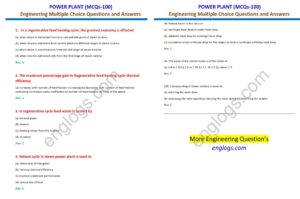What Is Power Plant Engineering:
Power plant engineering or power station engineering is a division of power engineering, and is defined as “the engineering and technology required for the production of central station electric power.” The field is focused on the generation of power for industries and communities, not for household power production.

The field is an interdisciplinary field, using the theoretical base of both mechanical and electrical engineering. The engineering aspect of power plant management has evolved with technology and has become progressively more complicated.
The introduction of nuclear technology and the progression of other existing technologies have allowed power to be created in more ways and on a larger scale than was previously possible.
The assignment of different types of engineers to the design, construction, and operation of a new power plant is dependent on the type of system being built such as whether it is a fossil fuel thermal power plant, nuclear power plant, hydroelectric plant, or solar plant.
What Does A Power Plant Engineer Do:
A power plant engineer maintains day-to-day operations in a power plant. Their main duties involve conducting operational tests, providing preventative maintenance on machines, inspecting thermal systems, and working closely with other plant personnel.
Is Power Engineering A Good Career:
Some believe that power engineering is a less strenuous and less stressful career than other engineering fields; it is also a stable and relatively well-paying job, which makes it a desirable career for those who are not looking for a high-profile engineering position.
History:
Power plant engineering got its start in the 1800s when small systems were used by individual factories to provide electrical power. Originally the only source of power came from DC, or direct current, systems. While this was suitable for business, electricity was not accessible for most of the public body.
During these times, the coal-powered steam engine was costly to run and there was no way for the power to be transmitted over distances. Hydroelectricity was one of the most utilized forms of power generation as water mills could be used to create power to transmit to small towns.
It wasn’t until the introduction of AC, or alternating current, power systems that allowed for the creation of power plants as we know them today. AC systems allowed power to be transmitted over larger distances than DC systems allowed and thus, large power stations were able to be created.
One of the progenitors of long-distance power transmission was the Lauffen to Frankfurt power plant which spanned 109 miles.
The Lauffen-Frankfurt demonstrated how three-phase power could be effectively applied to transmit power over long distances.
The engineering knowledge needed to perform these tasks enlists the help of several fields of engineering including mechanical, electrical, nuclear, and civil engineers. When power plants were up and coming, engineering tasks needed to create these facilities mainly consisted of mechanical, civil, and electrical engineers.
These disciplines allowed for the planning and construction of power plants. But when nuclear power plants were created it introduced nuclear engineers to perform the calculations necessary to maintain safety standards.
Thanks Wiki



